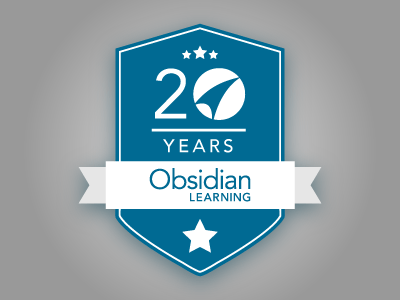Mobile learning can be quick to produce, or it can be a time suck to create, deploy, and support. Here are five tips to put you on the path to mastering the art of learning on the go.

With any learning challenge, it’s a good idea to get the lay of the land and get your mind right before you charge into a course of action. These five points will set you up for mobile learning success.
1. Consider security and tracking requirements up front.
Are you dealing with sensitive personal or proprietary data? Do you need to track who has taken and completed the training successfully? Will all your learners be inside your corporate firewall, or will contractors, customers, or other outsiders also need access to the training?
The answers to these questions make a fundamental difference as to which platforms you can use, and even what types of interaction are possible. If your organization is a large corporation, you’ll likely find that instead of a Facebook group, your company requires you to use social media apps deployed inside the firewall. Consult with your IT department and bring in programmers to make sure you have solid answers before you begin cranking out content.
More security and tracking usually means more login screens and other hoops to jump through for the learner. The more hoops, the less likely a learner will persevere to completion. Look for the best balance of access, security, and tracking.
2. Give learners what they came for.
People expect mobile content to be simple, short, fast, and easy to access. If it’s not, they quickly become frustrated and click away. If they remember a bad experience from the last time they tried to access your content, they won’t come back. So give them what they expect:
- The content they are looking for.
- That loads quickly and displays correctly on their device.
- In short chunks that get right to the point. Think two to three minutes max to watch a video; less to read a procedure or get all they need from an infographic.
3. Think of engagement differently.
In web-based training, engagement is often equated with screen interactions. The smaller the device, the more awkward and cumbersome screen interactions become. No one wants to feel like their fingers are too fat or your graphics and buttons are too small.
Examples of engagement in mobile learning:
- Touches spread out over time (e.g., text messages with a challenge of the week or tip of the day)
- Activities that learners report back on after completion (e.g., interview someone at your job site to ask a question, then post his or her answer in a course forum)
- Games that incentivize participation (e.g., get 10 points for each task your team completes, and the first team to reach 50 wins this round or gets swag at the next town hall meeting)
4. Use mobile learning for what it does best.
Mobile learning has been used successfully to teach languages (Duolingo, Babbel, Rosetta Stone, etc.), but most other adult mobile learning is really performance support. It’s that YouTube how-to video you watched while replacing your garbage disposal, or the instructions you found to disable your phone’s weather alert after it woke you at 2:49 AM. In corporate settings, mobile learning is often used to reinforce or refresh after the core initial learning.
Example 1: Infographic. Infographics can encapsulate a lot of knowledge in a small space, which makes them a natural choice for mobile learning. This example about Designing for Mobile Learning resizes to display well on desktops, tablets, and phones.
Example 2: Onboarding Portal. In onboarding training, appliance salespeople learn detailed specs and selling points for many models. After training, they need to refresh their knowledge to make sure they get the details right when dealing with customers.
We built this info-packed reference portal to be easy to navigate with a minimum number of clicks to reach answers, and to match the desired feel of a sales experience for an upmarket brand—elegant, sleek, and high value. It doesn’t replace the onboarding training—it extends that learning into the work place.
5. For big impact, make mobile learning part of a blended learning strategy.
In the corporate world, learning isn’t just about acquiring knowledge. It’s about behavior change. Mobile learning can be a powerful component in a strategy focused on behavioral outcomes. Here’s an example from my own workplace.
We all know that exercising more, eating well, and getting enough sleep make us healthier. We even know we would feel better and probably live longer if we enact those behaviors. But changing engrained habits is hard.
There’s no one outside my family with a bigger financial stake in my health—or at least in my avoiding illness and its attendant costs—than my insurance company. Recently my company changed insurance providers. Our new insurer offers a wellness program. As a learning professional, I am fascinated by how they incorporate mobile learning.
The program includes awareness, education, participation incentives (gift cards and premium reductions), and lots and lots of engagement and reinforcement. Points are awarded in varying amounts for everything from getting a health screening to downloading the wellness app, keeping a sleep log, or checking in at a gym. (The last three are mobile interactions.) Of course the points drive me to do the things the insurer values most, but they also boost my motivation. There’s something about earning points that’s hard to resist. The point system is structured so I see big gains early on, when I would be most likely to fall out of the program. This is a smart retention strategy that promotes what both parties want: me off the couch.
Most functionality is available on an app on my cell phone, with some of the more complex functions available only on the website. When I run into an issue, I could call the tech support number. But what I actually do is email “my guy.” My guy is the real live human who visited our offices to enroll our employees in the wellness program. He knows my name and is the single point of contact I need, which humanizes the whole experience for me.
My points and progress are displayed on a dashboard I see first thing when I open the app on my phone. I can see my recent achievements and how close I am to reaching the next big milestone. It’s all set up to get me hooked and keep me hooked long enough to establish new, healthier habits, with education sprinkled liberally along the way.
Only two weeks after our wellness program onboarding day, several employees have already achieved the first big milestone with its gift cards and reduced premiums. At the end of meetings, people linger to share tips on how to rack up wellness points. Someone set up a company team for an eight-day walking challenge, and several of us immediately joined.
Most companies only dream of achieving this much interest, engagement, and behavior change from their programs.
Takeaways from this example of an integrated behavior change program:
- Securely dealing with HIPAA information and tracking user accomplishments are baked into the design.
- The mobile elements (app, videos, quick reference pages, and other interactive elements) are integrated into an overall program which includes education, tangible and intangible incentives, and a strong communication program supported by occasional live human interaction.
- The mobile aspects (and the entire program) give me control over which activities I pursue, what I learn and when, and how I am contacted. This is empowering and encourages participation.
- The dashboard serves up the information I want to see, and focuses my attention on the things that motivate me to continue.
- The insurer’s priorities shape my choices through the point weighting of different activities, but I don’t mind because I perceive our interests as aligned.
- Points are fun. Achieving rewards is fun. Team challenges are fun. Does it need to be said that fun is motivating? Adding an element of competition, against ourselves or in teams, wakes us up a little and adds spice to the learning and practicing, and to the gradual business of changing habits and behavior.
That’s a big program with lots of investment behind it. But whether your training needs are large or small, you can use these key learnings to shake up your thinking and move your organization closer to mastering the art of learning on the go:
- Consider security and tracking requirements up front.
- Give learners what they came for.
- Think of engagement differently.
- Use mobile learning for what it does best.
- For big impact, make mobile learning part of a blended learning strategy.








